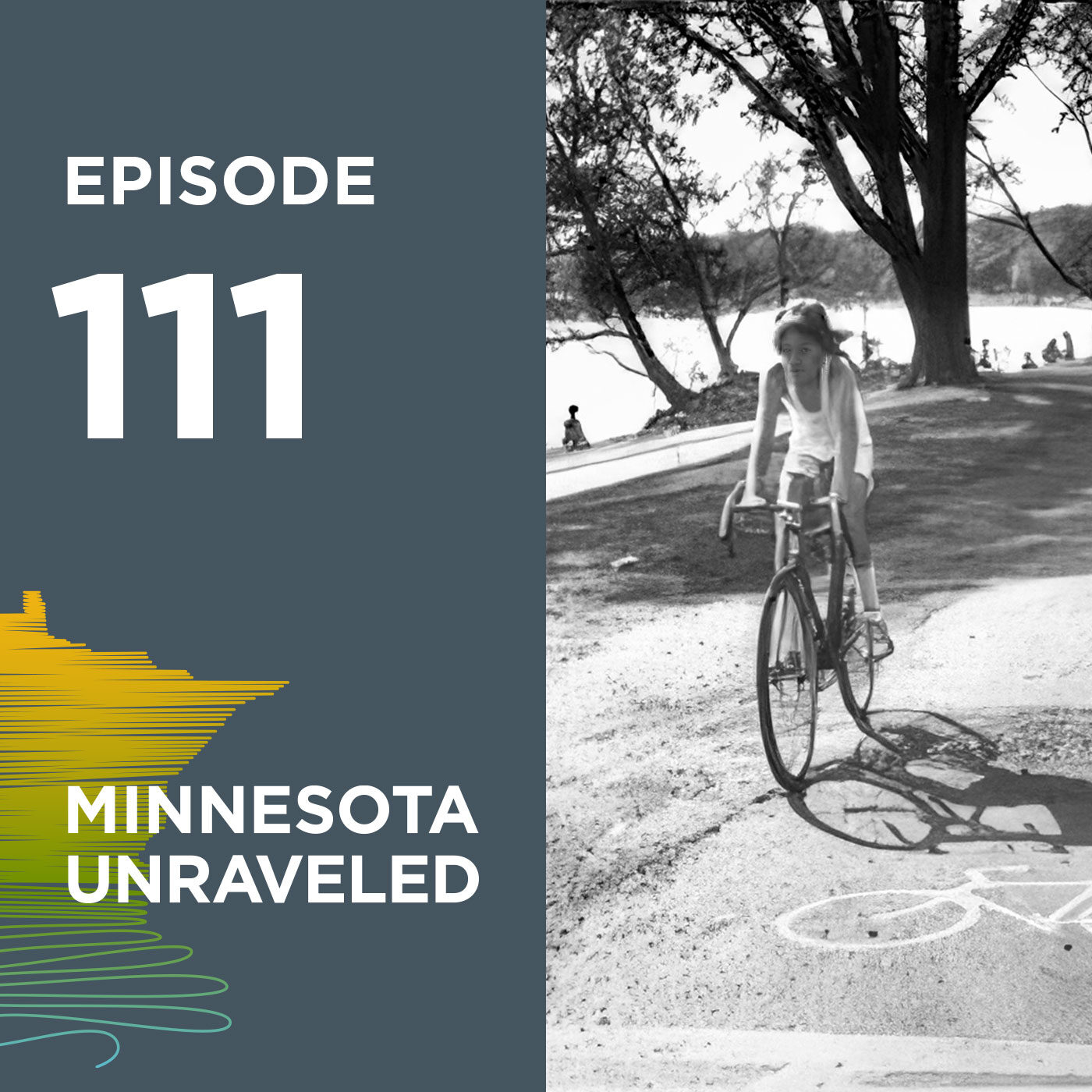History on Two Wheels: Bicycles and Bike Paths in Minnesota (episode 111)
Many places around the world are famous for their love of cycling—think Amsterdam in the Netherlands, or Portland, Oregon. But head to Como Lake in St. Paul, or the Mill Towns Trail in Northfield on a sunny spring day, and you’ll find flocks of cyclists taking advantage of the weather and the well-loved bike paths. How did biking find a place in the hearts of Minnesotans? And how did the robust biking infrastructure in the state come to be?
In this episode, host and historian Dr. Chantel Rodríguez explores the evolution of the bicycle in the late 19th century, as well as the cycling craze that followed. Chantel also examines how biking transformed mobility for both women and people in rural areas of the state, as well as the safety and structure of streets themselves. To gain insight into these questions, Chantel spoke with historian and bicycle planner Peter Bird, founder of Tamales y Bicicletas José Luis Villaseñor, and former city councilwoman and longtime Northfield resident Peggy Prowe.

Transcripts
Guests

José Luis Villaseñor
José Luis Villaseñor is the son of Mexican immigrant parents and founder of Tamales y Bicicletas. José Luis works on food justice issues within his community of South Minneapolis. José Luis inspires and leans on the use of urban farming and biking as tools for healing to decolonize our bodies, minds, and food systems; as an educator in radical-outdoor pedagogy, he believes that cultural empowerment and the reclaiming of our Indigenous technologies are the pillars that strengthen our families and our communities. José Luis is also a father of three boys and a founding member of South Side Bike Club.

Peggy Prowe
Growing up in Topeka, Kansas, Peggy’s love of the outdoors began while biking with her mother and family. She graduated with honors from the University of Kansas before completing a master’s degree in physical education from Emporia State Teacher College. In 1966 she accepted a job at Carleton College in Northfield, MN where she spent 26 years teaching physical education.
Prowe has been an active member of the Northfield community, serving as a city councilwoman from 1990-2000. A lifetime cyclist, she is a longtime advocate of the Mill Towns Bike Trail and established the Northfield Pedalers, a group for senior bicyclists. As a former councilwoman and member of both the Environmental Quality Commission and Park and Recreation Advisory Boards, she has dedicated time and miles to connecting communities through trails. Her accomplishments were recognized in 2009 with the naming of the Peggy Prowe Pedestrian Bridge linking the towns of Northfield and Dundas.

Peter Bird
Peter Bird has a particular interest in innovation within urban and transportation planning. He received a master degree in Urban and Regional Planning from the University of Colorado, Denver and worked in the field of urban and transportation planning, specifically as a bicycle advocate in Denver, CO and as a bicycle planner in Nashville, TN. In 2020, Bird was selected for the Robert Bosch Foundation Transatlantic Fellowship and has been in Germany for the past five years. Currently, he is with the Eindhoven University of Technology in the Netherlands where he continues his study of Cycling Cities and how planning practice can innovate to better elevate cycling, facilitating sustainable mobility transitions. He is also fundraising to publish Cycling Cities: The Minneapolis Experience, a book that explores nearly 150 years of cycling in Minneapolis.
Primary Sources
Houlgate, Isaac. Guide to Minneapolis Bicycle Paths: Index map for 1902, with history, directions, dealers, repairers, statistics, etc.: drawn, written and compiled from latest sources. Minneapolis: Houlgate, 1902.
St. Paul Cycle Path Association. “Cycling Routes around the Twin Cities.” St. Paul Cycle Path Association, 1899. Map Collection, Minnesota Historical Society, St. Paul. http://content.mnhs.org/maps/items/show/143
The Pathfinder Cyclists' Map and Guide Book: Containing a Road Map of that Part of Minnesota Within a Radius of 75 Miles of the Twin Cities. Minneapolis: Blodgett and Moore, 1897.
Secondary Sources
Cox, Peter. "Chapter 2 Rethinking Bicycle Histories." In Invisible Bicycle: Parallel Histories and Different Timelines, edited by Tiina Mannisto-Funk and Timo Myllynatus, 23-47. Brill, 2019. doi: https://doi-org.ezp3.lib.umn.edu/10.1163/9789004289970_003
Epperson, Bruce D. Peddling Bicycles to America: The Rise of an Industry. McFarland and Company, 2010.
Huber, Molly. "Bicycling Craze, 1890s." MNopedia, Minnesota Historical Society. http://www.mnopedia.org/event/bicycling-craze-1890s
Marsh, Steve. “A Brief History of Bicycling in Minnesota.” Mpls St Paul Magazine, July 22, 2022, https://mspmag.com/arts-and-culture/timeline-bicycle-race/
Petty, Ross D. “Bicycling in Minneapolis in the Early 20th Century.” Minnesota History 62, no. 3 (Fall 2010): 84-95. https://storage.googleapis.com/mnhs-org-support/mn_history_articles/62/v62i03p084-095.pdf
Reid, Carlton. Roads Were Not Built for Cars : How Cyclists Were the First to Push for Good Roads and Became the Pioneers of Motoring. Island Press, 2015. doi:10.5822/978-1-61091-688-2.
Smith, Robert A. A Social History of the Bicycle, its Early Life and Times in America. American Heritage Press, 1972.
Spreng, Ron. "The 1890s Bicycling Craze in the Red River Valley." Minnesota History 54, no. 6 (Summer 1995): 268–282. http://collections.mnhs.org/MNHistoryMagazine/articles/54/v54i06p268-282.pdf
Wells, Christopher W. “The Changing Nature of Country Roads: Farmers, Reformers, and the Shifting Uses of Rural Space, 1880-1905.” Agricultural History 80, no. 2 (2006): 143–66. doi:10.1525/ah.2006.80.2.143.
 MNHS Podcast
Apr 10, 2025 6:00:00 AM
MNHS Podcast
Apr 10, 2025 6:00:00 AM

